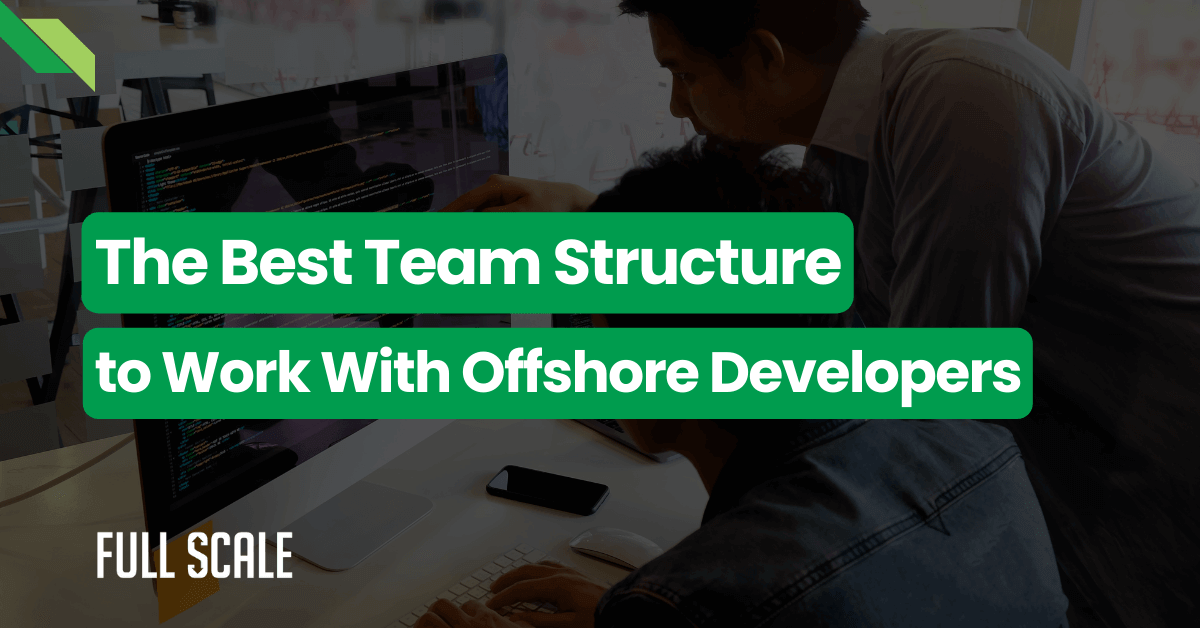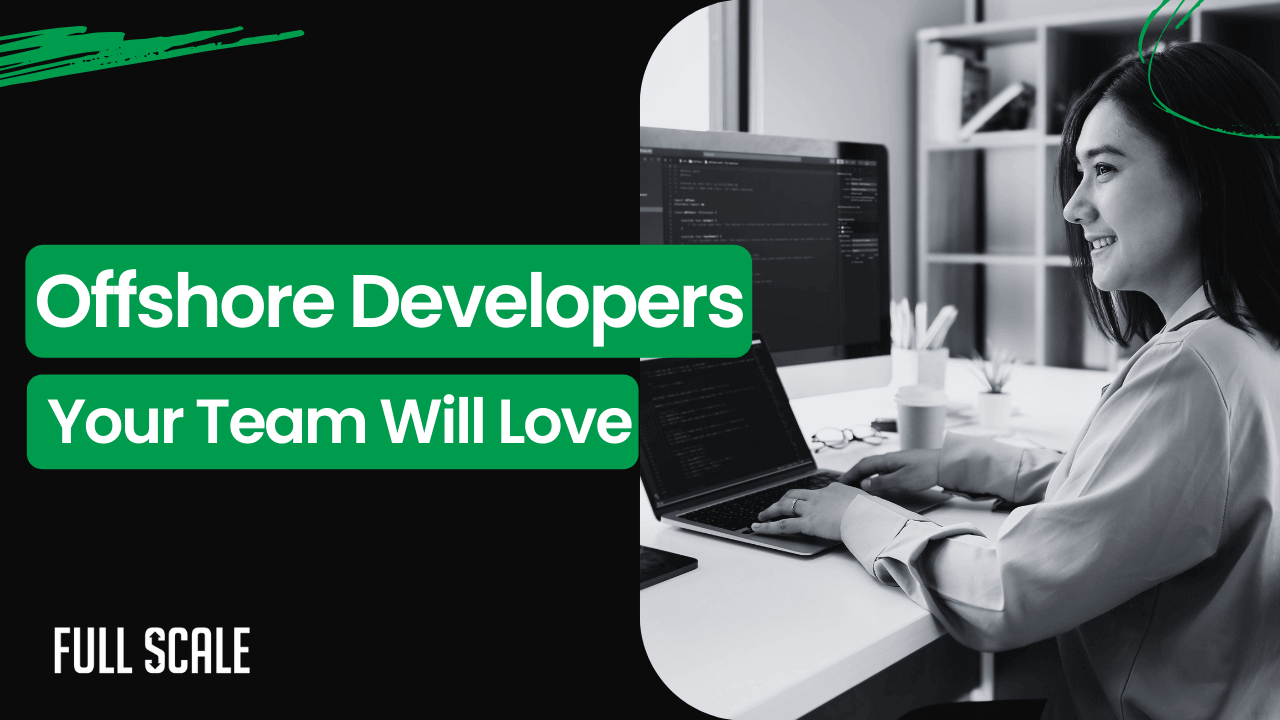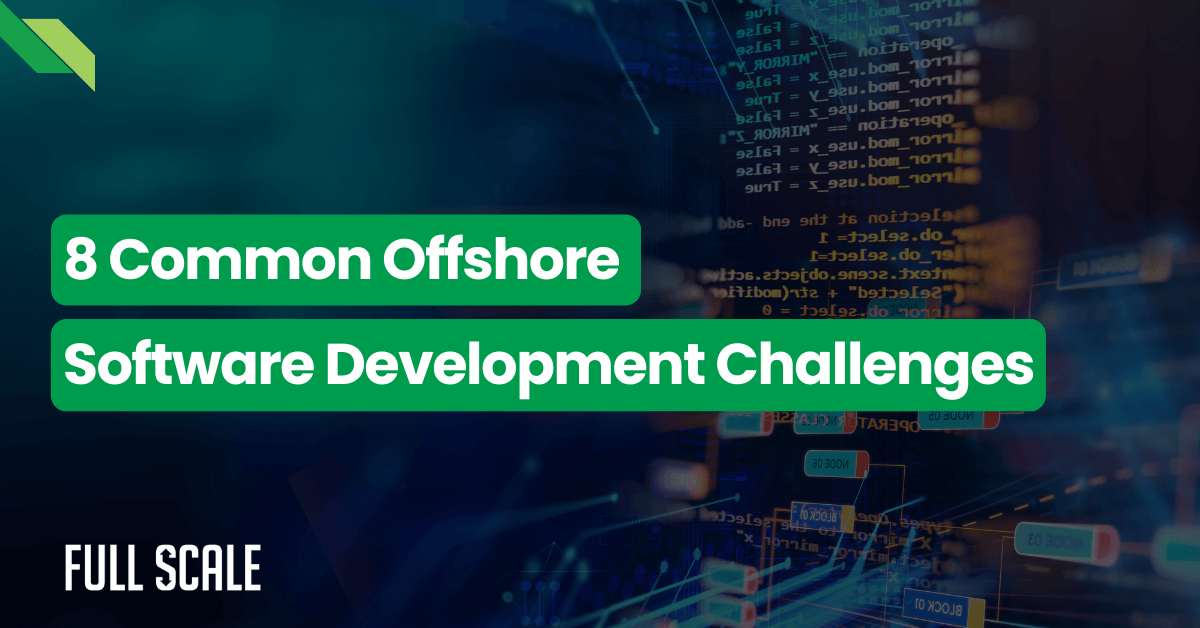With the emergence of AI and other advanced technologies, the tech landscape has become more competitive than ever.
CTOs and engineering leaders face mounting pressure to deliver quality products while managing tight budgets.
Offshore ROI has become a critical consideration for many struggling to reconcile these competing demands. The hidden costs of maintaining in-house development teams often go unrecognized.
Recent industry data highlights the growing financial pressure:
- Software engineer salaries in Silicon Valley increased 34% from 2020 to 2024, now averaging $189,000 (Hired’s 2024 State of Tech Salaries Report)
- Companies spend an average of $32,500 in recruitment costs per technical hire (Deloitte Human Capital Trends 2024)
- Remote work adoption has expanded offshore development spending by 71% since 2020 (Gartner IT Spending Forecast 2024)
This comprehensive analysis reveals the true financial impact of in-house development compared to offshore alternatives. We will examine the complete cost structure beyond base salaries and provide actionable insights for optimizing your development budget.
The True Cost Equation of In-House Development
When calculating the expense of your development team, looking beyond base salaries is essential. Total compensation packages in competitive markets include numerous additional costs that significantly impact your bottom line.
Beyond the Salary: Total Compensation Packages in Competitive Markets
Base salaries represent only part of the financial commitment to in-house developers. The full compensation package includes several components that dramatically increase your overall investment.
Equity packages for senior developers typically range from 0.05% to 0.5%, depending on company stage.
Annual bonuses can add 10-20% to base salaries for top performers. Health insurance, retirement plans, and other benefits add approximately 25-35% to base compensation.
| Compensation Component | Cost Impact | Example ($150K Base Salary) |
| Base Salary | 100% | $150,000 |
| Equity (annualized value) | 15-30% | $22,500-$45,000 |
| Annual Bonuses | 10-20% | $15,000-$30,000 |
| Health Insurance | 12-18% | $18,000-$27,000 |
| Retirement Benefits | 3-6% | $4,500-$9,000 |
| Other Benefits | 5-10% | $7,500-$15,000 |
| Total Annual Cost | 145-184% | $217,500-$276,000 |
This detailed breakdown shows how a seemingly straightforward $150K salary often translates to well over $200K in actual annual costs per developer. These figures represent standard packages required to attract and retain talent in competitive markets.
Infrastructure and Operational Expenses
Physical infrastructure and ongoing operational costs add another substantial layer of expense. These costs persist regardless of development productivity or output.
Office space in tech hubs comes at a premium price that continues to rise. Equipment costs include not just initial purchases but ongoing upgrades and maintenance. Administrative overhead includes HR support, management time, and compliance costs.
| Expense Category | Annual Cost Per Developer | Notes |
| Office Space (Tech Hubs) | $15,000-$25,000 | Based on 150-200 sq ft per person at $100-125/sq ft |
| Hardware & Equipment | $3,000-$5,000 | Initial setup plus refresh cycle |
| Software Licenses | $5,000-$12,000 | Development tools, enterprise software |
| IT Support | $2,500-$4,000 | Help desk, security, maintenance |
| Administrative Overhead | $8,000-$15,000 | HR, facilities, management |
| Total Annual Infrastructure Cost | $33,500-$61,000 |
These operational expenses represent fixed costs that remain constant regardless of developer productivity. When factored into your talent investment, they significantly increase the actual cost of each in-house developer.
Recruitment and Retention Costs
The process of finding, hiring, and keeping top talent carries its own substantial price tag. These costs are often overlooked in budget planning.
Technical hiring involves extensive screening, multiple interviews, and competitive offers. Time-to-fill metrics show the opportunity cost of vacant positions. High turnover rates compound these expenses through repetitive hiring cycles.
| Recruitment Activity | Cost | Industry Average |
| Job Postings | $500-$1,500 | Per role |
| Technical Screening Tools | $1,000-$3,000 | Per role |
| Recruiter Time | $8,000-$15,000 | Internal resource allocation |
| Interview Time (Engineering Team) | $10,000-$20,000 | Based on average, 15-20 hours per hire |
| Onboarding Cost | $10,000-$20,000 | First 3 months |
| Lost Productivity During Vacancy | $20,000-$40,000 | Based on 2-3 month vacancy |
| Total Cost Per Hire | $49,500-$99,500 |
With tech industry turnover rates averaging 13.2% annually, these recruitment costs recur frequently. Calculating this expense across your entire engineering team reveals a significant ongoing investment.
Hidden Costs That CFOs and CTOs Often Miss
Beyond direct expenses lie several consequential costs that remain invisible on standard balance sheets. These hidden costs can dramatically impact your development economics.
Opportunity Costs of Lengthy Hiring Processes
Extended vacancies and drawn-out recruitment create substantial opportunity costs directly affecting your bottom line. These delays impact both immediate productivity and long-term market positioning.
In competitive markets, the average time to hire for specialized technical roles now exceeds 60 days. Product launch delays resulting from understaffed teams can cost companies significant market share. Development velocity decreases when teams operate below optimal capacity.
| Impact Area | Cost Estimate | Calculation Basis |
| Release Delays | $50,000-$250,000+ | Per month of delay, varies by product |
| Market Opportunity Loss | $100,000-$1M+ | Varies by market and competition |
| Team Productivity Reduction | 15-30% | For teams operating under capacity |
| Customer Acquisition Delay | $10,000-$100,000 | Based on typical CAC and growth targets |
A recent case study from a mid-sized SaaS company revealed that a six-month delay in releasing a key feature cost approximately $350,000 in projected revenue. This tangible impact stemmed directly from prolonged developer vacancies.
Technical Debt Accumulation Due to Rushed Hiring
Pressure to fill positions quickly often leads to compromised hiring standards. These compromises create long-term technical debt with significant financial implications.
Rushed recruitment can lead to suboptimal technical skill matches. When teams lack proper expertise, code quality suffers. Future development velocity slows as technical debt compounds.
| Technical Debt Factor | Financial Impact | Industry Data Point |
| Code Refactoring Needs | 20-40% of Development Time | Source: Software Maintenance Studies |
| Bug Fix Frequency | 15-30% Increase | With suboptimal talent hiring |
| System Performance Issues | $10,000-$100,000 | Remediation costs |
| Security Vulnerabilities | $50,000-$500,000+ | Based on breach response costs |
Research shows technical debt typically costs organizations 25-40% of their development capacity. Teams with skill gaps created by hasty hiring often experience even higher maintenance burdens.
Productivity Fluctuations and Team Dynamics
Team composition changes create productivity ripples that extend far beyond the affected positions. These fluctuations significantly impact overall development economics.
New developers typically take 3-6 months to reach full productivity. Knowledge transfer requires substantial time from senior team members. Team cohesion suffers during periods of high turnover.
| Productivity Factor | Impact Duration | Cost Estimate |
| Onboarding Ramp-up | 3-6 Months | 30-60% Reduced Output |
| Knowledge Transfer | 1-3 Months | 10-20% Team Productivity Drop |
| Team Cohesion Rebuilding | 2-4 Months | 5-15% Efficiency Reduction |
| Process Relearning | 1-2 Months | 10-20% Increased Error Rate |
Employee turnover creates cascading impacts beyond the departing individual. Research indicates that replacing a senior developer costs 1.5-2x their annual salary, including all productivity impacts.
Offshore Development ROI Analysis
Strategic offshore development presents compelling economic advantages for companies facing budget constraints. A systematic evaluation reveals clear financial benefits.
Global Talent Access and Quality Considerations
The global development market offers access to extensive talent pools with strong technical capabilities. These resources come at significantly different cost structures than domestic options.
Development hubs in Eastern Europe, Latin America, and Asia offer varied specializations. Educational standards in these regions often emphasize technical fundamentals. Experience profiles show strong capabilities in modern development frameworks.
| Region | Technical Specialties | Education Profile | Experience Level |
| Eastern Europe | Backend, Algorithm, Security | Strong CS Fundamentals | 3-7 Years Average |
| Latin America | Full-Stack, Mobile, DevOps | Engineering Focus | 2-5 Years Average |
| Southeast Asia | Frontend, QA, Support | Technical Degrees | 2-6 Years Average |
| India | Enterprise, Legacy, Cloud | Engineering & IT Degrees | 3-8 Years Average |
Full Scale’s rigorous vetting process ensures access to top technical talent across these regions. Our selection criteria emphasize not only technical skills but also communication capabilities and cultural alignment.
Direct Cost Comparison Frameworks
The cost differential between in-house and offshore development represents immediate and substantial savings potential. These comparisons reveal significant financial advantages.
Salary differentials vary by region and specialization. Total engagement costs include communication infrastructure and management overhead. Long-term cost stability offers predictable budget planning.
| Developer Level | US Cost (Annual) | Offshore Cost (Annual) | Savings | Savings % |
| Junior | $80,000-$120,000 | $25,000-$40,000 | $55,000-$80,000 | 65-70% |
| Mid-Level | $120,000-$180,000 | $40,000-$60,000 | $80,000-$120,000 | 65-70% |
| Senior | $180,000-$250,000 | $60,000-$90,000 | $120,000-$160,000 | 65-70% |
| Lead/Architect | $220,000-$300,000 | $80,000-$120,000 | $140,000-$180,000 | 60-65% |
These figures account for fully loaded costs, including benefits and operational expenses. The substantial savings create an immediate positive impact on development economics.
Quick-Reference ROI Comparison
This side-by-side comparison highlights the dramatic financial difference between in-house and offshore development across key metrics. The data demonstrates both immediate and long-term economic advantages.
| Cost Factor | In-House Team (10 Developers) | Offshore Team (10 Developers) | Annual Savings |
| Direct Labor Cost | $1,700,000 | $590,000 | $1,110,000 |
| Infrastructure | $470,000 | $120,000 | $350,000 |
| Recruitment | $220,000 | $70,000 | $150,000 |
| Management Overhead | $350,000 | $180,000 | $170,000 |
| Total Annual Cost | $2,740,000 | $960,000 | $1,780,000 |
| Cost Per Developer | $274,000 | $96,000 | $178,000 |
| 5-Year Total Cost | $13,700,000 | $4,800,000 | $8,900,000 |
The compelling numbers above demonstrate why offshore ROI has become a primary consideration for budget-conscious technology leaders.
Flexible Scaling Advantages
Offshore development offers unparalleled scaling flexibility that creates both immediate and long-term financial benefits. This adaptability provides strategic advantages.
Team expansion happens on significantly compressed timelines. Project-based engagement models allow precise resource alignment. Dynamic scaling enables optimization for changing project requirements.
| Scaling Factor | In-House Timeline/Cost | Offshore Timeline/Cost | Advantage |
| Team Expansion (5 devs) | 2-4 Months / $50K-$100K | 2-4 Weeks / $10K-$20K | 8-10x Faster, 80% Cost Reduction |
| Project Ramp-up | 1-3 Months | 1-3 Weeks | 4x Faster Average |
| Specialty Skills Access | Limited by Location | Global Pool Access | Broader Skill Availability |
| Team Reduction | Complex, High Severance | Flexible, Minimal Overhead | Reduced Commitment Risk |
Full Scale’s established talent pools enable rapid team assembly with minimal recruitment overhead. Our streamlined onboarding processes accelerate time-to-productivity for new team members.
Beyond Simple Cost Cutting: Strategic Offshore Integration
Effective offshore implementation requires strategic approaches that go beyond simple cost reduction. Properly structured programs deliver both financial and operational benefits.
The Hybrid Team Approach
A balanced hybrid approach leverages the strengths of both in-house and offshore resources. This model optimizes for both cost efficiency and development effectiveness.
Core leadership and architectural functions typically remain in-house. Development execution shifts to offshore teams. Communication protocols bridge time zone and distance challenges.
| Function | Recommended Location | Rationale |
| Product Management | In-house | Market proximity, stakeholder interaction |
| Architecture | Hybrid | Local leadership with offshore implementation |
| UI/UX Design | In-house | User proximity and iteration speed |
| Backend Development | Offshore | Significant cost advantage, clear specifications |
| QA/Testing | Offshore | Excellent cost-benefit ratio, 24-hour testing cycle |
| DevOps | Hybrid | Infrastructure knowledge shared across teams |
Full Scale helps clients design optimal hybrid structures that balance cost savings with operational requirements. Our experience across diverse engagement models informs customized recommendations.
“Moving to a hybrid model with Full Scale’s offshore team reduced our development costs by 62% while actually increasing our velocity. The offshore ROI wasn’t just about cost savings—we improved our time-to-market by nearly 40%.”—CTO, Healthtech client
Quality Assurance Metrics
Maintaining quality standards requires systematic measurement and management. Properly implemented offshore programs often improve overall quality metrics.
Code quality metrics provide objective quality measurement. Release stability indicates effective testing processes. Customer satisfaction ultimately validates quality outcomes.
| Quality Dimension | Measurement Approach | Target Improvement |
| Code Quality | Static Analysis (SonarQube) | 15-25% Reduction in Technical Debt |
| Test Coverage | Automated Test Metrics | 20-30% Increase in Test Coverage |
| Defect Density | Issues per 1000 LOC | 20-40% Reduction Post-Integration |
| Release Stability | Hotfix Frequency | 30-50% Reduction in Emergency Fixes |
A financial services client working with Full Scale achieved a 34% reduction in production incidents after transitioning to our hybrid team model. Their test coverage increased from 62% to 87% within six months.
Technology Stack Considerations
Certain technologies and projects align more effectively with offshore models. Strategic technology selection enhances offshore ROI significantly.
Well-documented frameworks facilitate distributed development. Established technologies have broader talent availability. Communication tools bridge geographical separation.
| Technology Category | Offshore Suitability | Rationale |
| Backend Frameworks (Node.js, .NET, Java) | High | Clear specifications, established practices |
| Frontend Technologies (React, Angular) | Medium-High | Component-based architecture enables clear division |
| Mobile Development (iOS, Android) | High | Platform guidelines create natural standardization |
| Legacy Systems | Medium | Requires strong documentation, knowledge transfer |
| Emerging Technologies | Low-Medium | Limited talent pools, rapid evolution |
Full Scale maintains specialized talent pools aligned with in-demand technology stacks. Our screening processes validate deep expertise in specified technologies.
IT Budget Optimization Strategy
Translating offshore advantages into concrete financial benefits requires systematic planning and execution. Following established frameworks maximizes return on investment.
ROI Calculation Framework
Quantifying potential savings helps build compelling business cases for offshore transitions. A structured calculation approach ensures comprehensive assessment.
Direct labor cost differentials form the foundation of savings calculations. Productivity factors adjust for transition and communication overhead. Long-term benefits accumulate with sustained engagement.
| ROI Component | Calculation Approach | Typical Range |
| Year 1 Savings | (In-house Cost – Offshore Cost) × Team Size × 0.7 | 40-50% of In-house Cost |
| Year 2+ Savings | (In-house Cost – Offshore Cost) × Team Size × 0.9 | 55-65% of In-house Cost |
| Productivity Gain | Development Velocity Increase × Project Value | 15-30% Improvement |
| Time-to-Market Value | Market Opportunity × Accelerated Timeline | Project-Specific |
Implementation Roadmap
A phased approach to offshore integration minimizes risk while accelerating benefits. This structured methodology ensures sustainable long-term success.
The initial assessment identifies optimal offshore opportunities. Pilot projects validate the approach with limited investment. Scaled implementation expands successful patterns.
| Phase | Timeline | Objectives | Expected Outcomes |
| Assessment | Weeks 1-2 | Evaluate current costs, identify candidates | Clear offshore strategy, ROI projections |
| Pilot Selection | Weeks 3-4 | Choose initial projects, define success metrics | Balanced pilot portfolio, measurement framework |
| Team Assembly | Weeks 5-8 | Recruit and onboard the initial offshore team | 3-5 Developer team deployed |
| Pilot Execution | Months 3-5 | Complete initial projects, measure outcomes | Validated approach, refined processes |
| Scale Planning | Month 6 | Develop expansion roadmap based on results | Detailed scale strategy, 12-month forecast |
Full Scale’s experienced consultants guide clients through each implementation phase. Our established processes compress timeline uncertainty and accelerate positive offshore ROI.
Risk Mitigation Strategies
Addressing common offshore challenges proactively preserves projected financial benefits. Systematic risk management maximizes return on offshore investment.
Communication barriers represent primary offshore challenges. Intellectual property protection requires deliberate safeguards. Quality control depends on systematic oversight.
| Risk Category | Mitigation Approach | Full Scale Advantage |
| Communication | Structured reporting, collaboration tools | Established communication protocols, English proficiency |
| Quality Control | Automated testing, code reviews, clear standards | Built-in quality processes, technical leadership |
| Intellectual Property | Legal protections, access controls, NDAs | Comprehensive security framework, compliance verification |
| Knowledge Transfer | Documentation requirements, overlapping responsibilities | Knowledge management tools, technical documentation |
Our clients benefit from lessons learned across hundreds of successful offshore implementations. This experience translates directly to reduced risk and accelerated benefit realization.
The Bottom Line: Transforming Development Economics
The financial equation for in-house development has shifted dramatically in recent years. Rising domestic costs create compelling incentives for offshore alternatives.
Strategic offshore development delivers 60-70% cost savings compared to equivalent in-house teams. Beyond direct savings, companies gain access to global talent pools and enhanced scaling flexibility.
Full Scale’s established offshore development model provides immediate access to these benefits without implementation complexity. Our proven approach eliminates common offshore challenges while maximizing financial advantages.
Maximize Your Offshore ROI with Full Scale’s Expertise
Managing development costs effectively is critical for companies to maintain competitiveness while delivering high-quality software on time.
At Full Scale, we specialize in helping businesses like yours build and manage offshore development teams equipped with the skills and processes to maximize your offshore ROI while maintaining superior quality.
Why Full Scale?
- Expert Development Teams: Our skilled developers are thoroughly vetted for both technical expertise and communication skills.
- Seamless Integration: Our teams integrate effortlessly with your existing processes, ensuring smooth collaboration.
- Tailored Solutions: We align with your specific technology and business requirements.
- Increased Efficiency: Focus on strategic goals while we help you reduce development costs by 60-70%.
Don’t let unsustainable development costs limit your growth. Schedule a free consultation today to learn how Full Scale can transform your development economics.
Get A Custom Consultation for Offshore ROI
FAQs: Offshore ROI
What exactly is offshore ROI, and how is it calculated?
Offshore ROI measures the return on investment from using offshore development resources compared to in-house teams. It’s calculated by:
- Subtracting offshore costs from in-house costs to determine savings
- Factoring in productivity adjustments during the transition (typically 70% year 1, 90% year 2+)
- Adding value to accelerated development timelines and market opportunities
- Subtracting transition and management costs
- Dividing net benefit by total investment costs
Most companies see 40-50% offshore ROI in year one, improving to 55-65% in subsequent years.
What are the biggest hidden costs of in-house development teams?
Beyond obvious salary expenses, in-house development teams incur several substantial hidden costs:
- Opportunity costs from lengthy hiring processes (60+ days on average)
- Technical debt accumulation from rushed or compromised hiring
- Productivity fluctuations during team changes (3-6 months for new hires to reach full productivity)
- Knowledge transfer overhead when employees depart
- Team cohesion rebuilding after turnover
- Management overhead for larger teams
These hidden costs typically add 40-60% to the visible expense of in-house development.
Which development functions are best suited for offshore teams?
Not all development functions yield equal offshore ROI. The best candidates include:
- Backend development (high suitability due to clear specifications)
- Quality assurance and testing (excellent cost-benefit ratio)
- Mobile application development (clear platform guidelines)
- Maintenance and support functions (well-defined processes)
- DevOps implementation (after initial setup)
Functions requiring frequent stakeholder interaction or deep domain knowledge may be better kept in-house or managed through a hybrid approach.
How does Full Scale ensure quality with offshore development teams?
Full Scale maintains high-quality standards through a multi-faceted approach:
- Rigorous vetting process that accepts only the top 5% of applicants
- English proficiency requirements for all team members
- Established communication protocols and collaboration tools
- Regular code reviews and automated quality checks
- Dedicated technical leadership for each project
- Comprehensive documentation requirements
- Continuous training and skill development programs
- Ongoing performance monitoring with client feedback integration
This systematic approach ensures offshore teams maintain or exceed the quality standards of in-house development.
What are the most common challenges when implementing offshore development?
Companies implementing offshore development typically face several challenges:
- Communication barriers from time zone differences and language nuances
- Knowledge transfer inefficiencies during the transition
- Cultural differences in work approach and problem-solving
- Intellectual property protection concerns
- Quality control and oversight limitations
- Project management complexity with distributed teams
Successful implementations address these challenges proactively through structured processes, clear documentation, and appropriate collaboration tools.
How long does it take to see positive ROI from offshore development?
Most companies begin seeing positive offshore ROI within:
- 1-3 months: Initial cost savings become apparent
- 3-6 months: Productivity reaches or exceeds previous levels
- 6-12 months: Full strategic benefits materialize
Factors affecting the timeline include:
- Project complexity and knowledge transfer requirements
- Team size and composition
- Previous offshore experience
- Implementation approach (pilot vs. full transition)
- Industry and regulatory considerations
Companies following Full Scale’s structured implementation methodology typically achieve break-even within 4-6 months and substantial positive offshore ROI within 6-12 months.

Matt Watson is a serial tech entrepreneur who has started four companies and had a nine-figure exit. He was the founder and CTO of VinSolutions, the #1 CRM software used in today’s automotive industry. He has over twenty years of experience working as a tech CTO and building cutting-edge SaaS solutions.
As the CEO of Full Scale, he has helped over 100 tech companies build their software services and development teams. Full Scale specializes in helping tech companies grow by augmenting their in-house teams with software development talent from the Philippines.
Matt hosts Startup Hustle, a top podcast about entrepreneurship with over 6 million downloads. He has a wealth of knowledge about startups and business from his personal experience and from interviewing hundreds of other entrepreneurs.




